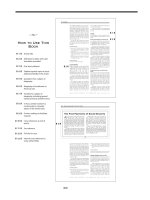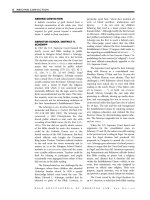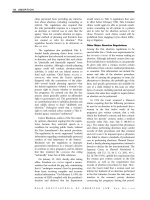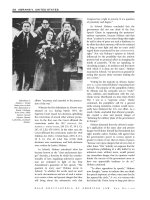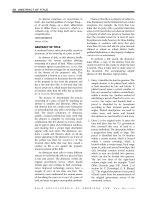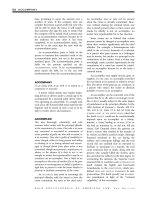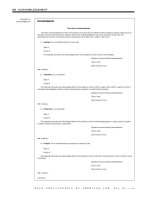Gale Encyclopedia Of American Law 3Rd Edition Volume 1 P20 doc
Bạn đang xem bản rút gọn của tài liệu. Xem và tải ngay bản đầy đủ của tài liệu tại đây (279.95 KB, 10 trang )
[repealed 1976]). This act encouraged the
westward expansion of European Americans
by selling federally owned lands for farming.
Another method of sale was land debt, a
financial arrangement in which farmers agreed
to pay the federal government a certain amount
from their yearly profits in exchange for the
land. Congress passed subsequent legislation
concerning land ownership for farming pur-
poses, but federal lands were eventually
exhausted, and in 1976 these late-nineteenth-
and early-twentieth-century acts became unnec-
essary and were repealed.
The colonial and pioneer families who
practiced farming generally raised a variety of
animals and crops, depending on what the soil
would yield. This seminal arrangement came to
be known as the “family farm.” The family farm
community was rich in resources derived from
land, not money, and from this unique prosperity
grew a lifestyle with a status all its own.
Expendable income was not a priority for farm
families. The values attached to their way of life
placed a higher premium on plentiful food, vast
land ownership, and a spiritual fulfillment derived
from farming. Farmwork was difficult, and the
farmer was different from the rest of society; it
was against this backdrop that federal and state
legislators began to work when addressing the
pressing issues that farmers would come to face.
The years following the Civil War were
especially fruitful for farming communities.
WORLD WAR I saw an increase in the value of farm
products, and in the Roaring Twenties, robust
prices were maintained by a general public
capable of buying food and clothing. However,
in the months before the
STOCK MARKET crash of
October 1929, the value of farmland and its
products began to decrease. This was due in part
to high tariffs on manufacturing equipment
essential to farming, which allowed U.S. manu-
facturers to price farming equipment without
foreign competition. It was also due in part to a
new emphasis on mass productivity inspired by
the Industrial Revolution. The ability of farmers
to increase production on less land led to lower
prices and, eventually, fewer family farms.
The Great Depression of the 1930s eliminated
many family farms. As the general public
became less able to buy such basic farm products
as food and clothing, food prices dropped
drastically, and farmers found themselves with-
out the profits they needed in order to pay their
mortgages. Foreclosures became routine. Farm
As farm foreclosures
became commonplace
during the Great
Depression, some
farmers resorted to
violence to try to keep
their property. This
image shows Iowa
National Guard
members, armed with
rifles, ready to put
down any disturbance
during an auction
in Crawford County
in 1933.
FDR LIBRARY
GALE ENCYCLOPEDIA OF AMERICAN LAW, 3RD E DITION
178 AGRICULTURAL LAW
families considered foreclosures a breach of the
government’s promise to allow productive farm
families to keep their land, and vast numbers of
farmers organized to withhold food from their
markets in an effort to force product prices
higher. A smaller number of farmers resorted to
violence to prevent other farmers from deliver-
ing their goods to market. Several foreclosures
were also preve nted by force.
The unrest of the early 1930s in the Great
Plains states eventually led to widespread state
legislation that limited the rights of banks to
foreclose on farms with undue haste. Action was
also taken on the federal level. To avoid a
national farmers’ strike planned for May 13,
1933, President
FRANKLIN D. ROOSEVELT signed the
Agricultural Adjustment Act (7 U.S.C.A. § 601
et seq.) on May 12. This act was the first in a
series of federal laws that provided
COMPENSA-
TION
to farmers who voluntarily reduced their
output. Parts of the act were declared unconsti-
tutional by the Supre me Court in 1936, in part
because the Court considered agriculture a
matter of local concern. Congress and President
Roosevelt continued to press the issue, with
the amended Agricultural Adjustment Act of
1938, which contained more federal control of
production, benefit payments, loans, insurance,
and soil conservation.
The
TEST CASE for the new Agricultural
Adjustment Act was Wickard v. Filburn, 317
U.S. 111, 63 S. Ct. 82, 87 L. Ed. 122 (1942). In
Wickard, Ohio farmer Roscoe C. Filburn sued
Secretary of Agriculture Claude R. Wickard over
the part of the act concerning wheat acreage
allotment. Under the act, the U.S.
DEPARTMENT
OF AGRICULTURE
(USDA) had designated 11.1
acres of Filburn’s land for wheat sowing and
established a normal wheat yield for this
acreage. Filburn defied the department’s direc-
tive by sowing wheat on more than 11.1 acres
and exceeding his yield. This constituted farm
marketing excess, and Filburn was penalized
$117.11 by the department. When Filburn
refused to pay the fine, the government issued
a
LIEN against his wheat, and the Agriculture
Committee denied him a marketing card. This
card was necessary to protect Filburn’s buyers
from
LIABILITY for the fine, and to protect buyers
from the government’s lien on Filburn’s wheat.
Filburn sued to invalidate the wheat-acreage-
allotment provision, arguing in part that it was
beyond the power of the federal government to
enforce such farming limitations. Even though
Filburn did not intend to sell much of the wheat,
the Supreme Court reasoned that because all
farm product surplus had a substantial effect on
interstate
COMMERCE, it was within the power of
the U.S. Congr ess to control it. This decision
affirmed the power of Congress to regulate all
things agrarian, and the U.S. farmer, for better or
worse, was left with a meddlesome lifetime friend
in the federal government.
As the United States enjoyed economic
prosperity through the 1950s and 1960s, t he
number of family farms remained relatively s table.
Farm families learned to work with the federal
government and its dizzying stream of agencies,
regulations, and paperwork. Nevertheless, the
mid-1980s saw another farm crisis. Widespread
financial difficulty led to the loss of more family
farms and prompted further federal action.
In response to this crisis, Congress passed
an extensive credit-relief package in 1985, over
the
PROTEST of President Ronald Reagan’s
agriculture secretary, John R. Block. The various
bills in this package provided for additional
Number and Acreage of U.S. Farms
Year
1990 1995 2000 2008
0
500
1,000
1,500
2,000
2,500
SOURCE: U.S. Department of Agriculture, National
Agricultural Statistics Service, Farms, Land in Farms,
and Livestock Operations, annual.
Total acreage (in millions)
Average acreage per farm
Number of farms (in thousands)
ILLUSTRATION BY GGS CREATIVE RESOURCES. REPRODUCED BY
PERMISSION OF GALE, A PART OF CENGAGE LEARNING.
GALE ENCYCLOPEDIA OF AMERICAN LAW, 3
RD E DITION
AGRICULTURAL LAW 179
federal monies for loan guarantees, reduction of
lender interest rates, and loan advancements.
This farm crisis was triggered by a combi-
nation of natural disasters, market shifts, lower
prices, and production improvements. Further-
more, the onset of corporate farming, which
involves mass production of farm products,
forced farm families to consistently reckon with
the harsh realities of the financial world.
Dissatisfaction with federal farm laws and
policy led Congress in 1996 to pass the Federal
Agriculture Improvement and Reform Act, which
came to be known as the Freedom to Farm Act
(Pub.L. 104–127, Apr. 4, 1996, 110 Stat. 888). The
law, which conservatives trumpeted as the means
to end 60 years of federal farm subsidies and to
reinvigorate the free market, reduced regulatory
burdens on farmers and ended requirements that
farmers idle land to qualify for crop subsidies.
However, the central part of the law consisted of
“market transition payments”—the USDA paid
farmers to compensate them for the possibility
that farm subsidies might end in six years. This
departed from the traditional federal practice
whereby support payments were inversely related
to crop prices—the higher the crop prices, the
lower the support payments.
In 1996 and 1997 the Freedom to Farm Act
gave farmers more than three times as much in
cash subsidies as they would have received
under the previous five-year farm bill. Even
with these payouts, farm income began to fall in
1998, leading Congress to reverse course and
authorize billions of dollars in farm relief. By
2002 Congress had abandoned the idea that the
federal government should not subsidize farm-
ers. It passed the Farm Security and Rural
INVESTMENT Act of 2002 (Farm Bill 2002), Pub.L.
107–171, May 13, 2002, 116 Stat. 134, which set
agricultural policy for the next six years. It is
estimated that the total subsidies paid out over
this period will reach $200 billion.
While government involvement in farming
continues, the face of U.S. farming is evolving.
Most farmers are now trained in business and
keep abreast of farming trends, technological and
manufacturing improvements, and the stock
market. Many family farms have adapted by
specializing in the mass production of one or two
particular foods or fibers, like corporate farms do.
Other farmers have formed what is called a
“cooperative,” a group of farmers dedicated to
the most profitable sale of their products. By
pooling their resources and producing a variety of
goods, cooperative farmers are able to weather
low-price periods and postpone sales until a
product price reaches a high level.
Agriculture has become a powerful
LOBBYING
group in state capitals across the country, and the
political issues are myriad. The industry itself is
split into competing special interests, according
to product. Family farms and cooperatives are
often at odds, although sometimes they join
forces against massive corporate farming. Farm-
ing interests are frequently opposed by advocates
for the environment and food purity. The
government does not always seem to act in the
best interests of farmers, and farm ers and their
creditors continually struggle for leverage. Fed-
eral and state regulations seek to provide some
predictability for the players in these struggles.
Federal Law
According to the Wickard case, the U.S. Congress
has the power to regulate agricultural production
under Article I, Section 8, of the federal
Constitution, and Congress has left virtually
nothing to chance. The numerous programs and
laws that promote and regulate farming are
overseen by the secretary of agriculture, who
represents the USDA in the president’s cabinet.
The USDA is the government agency that carries
out federal agricultural policy, and it is the most
important legal entity to the farmer.
Usually, some two dozen agencies are housed
within the USDA, all charged with carrying out
the various services and enforcing the numerous
regulations necessary for the efficient, safe
production of food and fiber. Other administra-
tive agencies can affect a farmer’s legal rights,
such as the
FOOD AND DRUG ADMINISTRATION (FDA),
the
INTERIOR DEPARTMENT, and the TREASURY
DEPARTMENT
, but the USDA is the single depart-
ment to which every farmer must answer .
The 2008 Farm Bill
In April 2008 Congress finally enacted the
massive Food, Conservation, and Energy Act of
2008, P.L. 110–246, more commonly referred to
as the Farm Bill. The entire law incorporated a
$288 billion, five-year agricultural policy bill
that essentially continued the 2002 Farm Bill.
Specific initiatives were aimed at increased Food
Stamp benefits, research money for new pest
and disease control in crops, and support for
the production of cellulosic ethanol (an alter-
native energy).
GALE ENCYCLOPEDIA OF AMERICAN LAW, 3RD E DITION
180 AGRICULTURAL LAW
Other major provisions included the Aver-
age Crop Revenue Election (ACRE), which will
allow farmers to chose between continued
subsidies or revenue-based market oriented
protections; funding for local food programs,
including farmers’ market programs; and funds
for conservation and working land programs.
Section 9003 provides for grants of up to 30
percent of costs for developing and building
biorefineries demonstratively capable of pro-
ducing biofuels (all fuels not produced by corn
kernel starch). Section 15321 establishes a new
tax credit for producers of cellulosic biofuels
(produced from wood, grasses, or the non-
edible parts of plants). Section 9010 authorizes
the
COMMODITY CREDIT CORPORATION (CCC) to
purchase sugar from U.S. producers and sell it to
bioenergy producers. Section 9011 creates the
Biomass Crop Assistance Program supporting
the establishment and production of biomass
crops. Two other sections, 9009 and 9013, create
rural energy self-sufficiency initiatives to devel-
op community-wide renewable energy systems.
The Farm Bill also created the National
Institute of Food and Agriculture for federal
sector agricultural research. For fiscal years 2009
to 2012, the bill granted $78 million for organic
agricultural research; $230 million for specialty
crops; and $118 million for biomass research
and development.
The Agricultural Adjustment Acts establish
and maintain prices for crops by preventing
extreme fluctuations in their availability. These
acts empower the secretary of agriculture to
allot a certain amount of farmland for the
production of a specific crop, and to apportion
the land among the states capable of producing
the cro p. State agricultural committees then
assign a certain amount of the land to various
counties, and the counties in turn assign the
land to local farms. This system guards against
crop surpluses and shortages, and preserves
economic stability by preventing extreme fluc-
tuations in crop prices.
The
COMMODITY Credit Corporation (CCC)
exists within the USDA to further the goal of
stabilizing food prices and farmers’ incomes.
The CCC provides
DISASTER RELIEF to farmers, and
it controls prices through an elaborate system of
price support. Loans to farmers and govern-
mental buyouts of farm products allow the CCC
to maintain reasonable price levels. The secre-
tary of the CCC is also authorized to issue
subsidies, or governmental grants, to farmers as
another means of controlling prices by main-
taining farmers’ incomes. By encouraging or
discouraging the production of a particular food
or fiber through financial reward, subsidies
promote price stability in the markets.
Several federal programs help serve the same
purpose of price stability. The secretary of
agriculture may set national quotas for the
production of a certain farm product. Set-aside
conditions, also established by the secretary of
agriculture, require farmers to withhold pro-
duction on a certain amount of cropland during
a specified year. Diversion payments are made to
farmers who agree to divert a percentage of
their cropland to conservation uses, and the
Payment in Kind Program allows farmers to
divert farmland from production of a certain
commodity in exchange for a number of bushels
of the commodity normally produced on the
diverted land. Federal
CROP INSURANCE, emergen-
cy programs, and
INDEMNITY payment programs
protect farmers against unforeseen production
shortfalls. The
FARM CREDIT ADMINISTRATION,
established by Congress as an independent
agency in the
EXECUTIVE BRANCH of government,
provides funds for farmers who are unable to
purchase feed for livestock or seed for crops.
Also in place are federal programs and
regulations that provide for the coordination of
farm cooperatives, standardization of marketing
practices, quality and health inspections, the
promotion of market expansion, the reporting
of farm statistics, and the administration of soil
conservation efforts. For example, the Soil
Conservation and Domesti c Allotm ent Act (16
U.S.C.A. §§ 590 et seq. [1936]) directs the
secretary of agriculture to help farmers and
ranchers acquire the knowledge and skill to
preserve the quality of their soil. The federal
Food Stamp Program helps to support domestic
food consumption and economic stability for
consumers and farmers alike by subsidizing the
food purchases of people with low incomes.
Under Title VII of the United States Code,
the secretary of agriculture is charged with
coordinating educational outreach services. The
Morrill Act (7 U.S.C.A. §§ 301–05, 307, 308),
passed by Congress in 1863, granted public land
to institutions of higher education for the
purpose of teaching agriculture. In 1887 the
HATCH ACT (7 U.S.C.A. § 361a et seq.) created
agricultural experiment stations for colleges of
GALE ENCYCLOPEDIA OF AMERICAN LAW, 3RD E DITION
AGRICULTURAL LAW 181
agriculture, and in 1914 the Smith-Lever Act
(7 U.S.C.A. § 341 et seq.) created the Extension
Service, which allowed agriculture colleges to
educate farmers not enrolled in school.
In the Extension Service, agents are hired by
an agriculture college to help farmers address a
variety of farming issues, and to promote
progress in farming by providing farmers with
information on technological advances. Many
farm families have been helped by the land-grant
programs, but some critics have argued that this
college syste m too often emphasizes increased
productivity and frenzied technological advance-
ment at the exclusion of small-scale farm
operations. In the mid-1990s the Extension
Service began to branch out. The Minnesota
Extension Service, for example, began to address
such issues as teen drug abuse and child neglect.
This use of agricultural monies for social services
has disappointed some and pleased others.
One high-profile controversy involves the
Bovine Somatatropin (BST) bovine growth
hormone. The BST hormone increases the milk
output of dairy cows. The Milk Labeling Act
bills passed by Congress in April 1993 regulate
the use of the drug by requiring the secretary of
agriculture to conduct a study of its economic
effect on the dairy industry and on the federal
price support program for milk. The act also
requires the producers of the milk from cows
treated with BST to keep records on its manu-
facture and sale. Proponents of the drug praise its
production benefits, but opponents argue that
increasing productivity is less important than
ensuring food purity.
HOMESTEAD protection is another form of
federal relief, which helps keep farms out of
FORECLOSURE. To qualify for homestead protec-
tion, farmers must show that they have received a
gross farm income that is comparable to that of
other local farmers, and that at least 60 percent of
their income has come from farming. A 1993 case
challenged the definition of this type of relief.
Schmidt v. Espy, 9 F.3d 1352 (8th Cir. 1993) was a
suit brought by the Schmidt family to stop the
FmHA from calling in the Schmidts’ farm loan.
The USDA had ruled that because the Schmidts’
farm had suffered net losses, it could not qualify
for homestead protection. The Schmidts took
their case to the U.S. district court, which
affirmed the USDA’s decision.
The Eighth
CIRCUIT COURT of Appeals re-
versed the decision. According to the appeals
court, the statutory definition of income for
purposes of homestead protection is
GROSS
INCOME
, not gross profits. The court reasoned
that because homestead protection is normally
sought by financially distressed farmers, limit-
ing the protection to profitable farmers would
run contrary to the purpose of homestead
protection.
State Law
The TENTH AMENDMENT grants states the right to
pass laws that prom ote the general safety and
well-being of the public. Because courts have
found that agricultural production and con-
sumption directly affect public health and safety,
states are free to enact their own agricultural laws,
provided those laws do not conflict with federal
laws and regulations.
Many state laws provide for financial assis-
tance to farmers. By issuing loans or providing
emergency aid, states are able to ensure the
survival of family farms and continued agricul-
tural production. The states also have the power
to impose agricultural liens, which are claims
upon crops for unpaid debts. If a farmer is unable
to make timely payments on loans for services or
supplies, the state may sue the farmer to gain a
security interest in the farmer’s crops. States also
enact laws to supervise the inspection, grading,
sale, and storage of grain, fertilizer, and seed.
Municipalities can also set regulations that
ostensibly control agricultural production. The
subject of wetlands, for example, is within the
jurisdiction of local governing bodies. In Ruotolo
v. Madison Inland Wetlands Agency, No. CV
93-0433106, 1993 WL 544699 (Conn.Super.,
Dec. 23, 1993), Michael Ruotolo, a farmer in
Madison, Connecticut, challenged a
MUNICIPAL
regulation that prevented him from filling in
wetlands located on his property. Ruotolo
wanted to plant nursery stock on the area after
moving earth to raise the ground level, but
the Madison Wetlands Reg ulation precluded the
filling in of any wetlands. According to a state
statute, however, farming was permitted on
some wetlands of less than three acres.
Ruotolo asserted a right to farm, and argued
that because the state law and the local regulation
were in conflict, the state law should prevail.
However, in previous proceedings between
Ruotolo and the Madison Inland Wetlands
Agency, the agency had found that the wetlands
on Ruotolo’spropertyhad“continual flow,”
GALE ENCYCLOPEDIA OF AMERICAN LAW, 3RD E DITION
182 AGRICULTURAL LAW
and were therefore subject to more protection
than standing-water wetlands. Because the state
statute prevented even farmers with less than
three acres from filling in wetlands with
continual flow, Ruotolo was prevented from
farming the wetlands on his own property.
FURTHER READINGS
Barnes, Richard L. 1993. “The U.C.C.’s Insidious Preference
for Agronomy over Ecology in Farm Lending Deci-
sions.” University of Colorado Law Review 64.
Commodity Credit Corporation. Available online at www.
fsa.usda.gov/ccc/default.htm (accessed May 29, 2003).
Daniels, Tom, and Deborah Bowers. 1997. Holding Our
Ground: Protecting America’s Farms and Farmland.
Washington, D.C.: Island Press.
Department of Agriculture. 2009. “Food, Conservation, and
Energy Act of 2008.” Available online at http://www.
usda.gov/wps/portals; website home page: http://www.
usda.gov/ (accessed September 10, 2009)
Farm Credit Administration. Available online at www.fca.
gov (accessed May 29, 2003).
Gardner, Bruce L. 2002. American Agriculture in the
Twentieth Century: How It Flourished and What It Cost.
Cambridge, Mass.: Harvard Univ. Press.
Hamilton, Neil D. 1993. “Feeding Our Future: Six
Philosophical Issues Shaping Agricultural Law.”
Nebraska Law Review 72.
———. 1990. “The Study of Agricultural Law in the United
States: Education, Organization, and Practice.” Arkansas
Law Review 43.
Kimbrell, Andrew. 2002. Fatal Harvest: The Tragedy of
Industrial Agriculture. Washington, D.C.: Island Press.
Looney, J. W. 1994. Agricultural Law: Principles and Cases.
2d ed. New York: McGraw-Hill.
Meyer, Keith G., et al. 1985. Agricultural Law: Cases and
Materials. St. Paul, Minn.: West.
Prim, Richard. 1993. “Saving the Family Farm: Is Minnesota’s
Anti–Corporate Farm Statute the Answer?” Hamline
Journal of Public Law and Policy 14.
Sumner, Daniel A., ed. 1995. Agricultural Policy Reform in
the United States. Washington, D.C.: AEI Press.
CROSS REFERENCES
Agriculture Department; Agriculture Subsi dies; Environ-
mental Law; Land-Use Control; Zoning.
AGRICULTURE DEPARTMENT
The U.S. DEPARTMENT OF AGRICULTURE (USDA) is
an executive, cabinet-level department in the
federal government. It is directed by the secretary
of agriculture, who reports to the
PRESIDENT OF THE
UNITED STATES
. The USDA’s primary concern is the
nation’s agriculture industry, and the depart-
ment addresses this concern through numerous
economic, regulatory, environmental, and scien-
tific programs. The USDA provides financial aid
to farmers through loans, grants, and a system of
price supports. The USDA’s international efforts
promote domestically grown products abroad.
The department regulates the quality and output
of the grain, meat, and poultry industries.
Through various conservation programs, the
department helps protect soil, water, forests,
and other natural resources. The USDA also
administers the federal Food Stamp Program,
one of the
WELFARE system’s largest services.
The USDA h as a long h istory. As early as 1838,
farmers had urged Congress to create a federal
AGRICULTURE DEPARTMENT, but it took more than 20
years before t he idea gained widespread support .
On May 15, 1862, President
ABRAHAM LINCOLN
signed the Department o f Agriculture Organic Act
(12 Stat. 387, now c odified at 7 U.S. C.A> § 2201),
which c reated the department. The creation of the
USDA coincided with several other major events,
including the middle of the Civil War. Within days
of signing the act that created the USDA, Lincoln
also signed the
HOMESTEAD AC T OF 1862, which was
vital in the development of family farms in the
western United States.
The USDA was administered by a
COMMIS-
SIONER
of agriculture until 1889 (25 Stat. 659). In
1889, Congress enlarged the departmen t’s
powers and duties (7 U.S.C.A. §§ 2202, 2208).
It made the USDA the eighth executive depart-
ment in the federal government, and the
commissioner became the secretary of agricul-
ture. Federal lawmakers have tinkered with the
department ever since. Notably, programs pro-
viding economic aid to farmers were established
during the Great Depression, and these programs
have since become a firmly entrenched part of
federal law. Important contemporary reforms
have included federal welfare services such as the
Food Stamp Program, administered through the
Food and Nutrition Service since the 1970s, and
the Food, Agriculture, Conservation, and Trade
Act of 1990 (7 U.S.C.A. §§ 1421 note et seq.),
enacted to maintain the income of farmers.
Several federa l statutes have established the
department’s central role in administering
subsidy programs. These statues include: the
Federal Agriculture Improvement and Reform
Act of 1996 (Freedom to Farm Act) (Pub. L. No.
104–127, Apr. 4, 1996, 110 Stat. 888), the Farm
Security and Rural
INVESTMENT Act of 2002 (2002
Farm Bill) (Pub. L. No. 107–171, May 13, 2002,
116 Stat. 134), and the Food, Conservation, and
Energy Act of 2008 (2008 Farm Bill) (Pub. L. No.
110–246, 122 Stat. 1651).
The secretary of agriculture presides over an
elaborate
BUREAUCRACY. The deputy secretary
GALE ENCYCLOPEDIA OF AMERICAN LAW, 3RD E DITION
AGRICULTURE DEPARTMENT 183
runs day-to-day operations, serving as the
secretary’s principal adviser. Reporting to the
secretary and deputy secretary are six officers:
chief financial officer, general counsel, inspector
general, executive of operations, director of
communications, and chief information officer.
These officers and their staffs coordinate a
number of operations, including: the USDA’s
personnel management program; equal oppor-
tunity and
CIVIL RIGHTS activities; safety and health
activities; management improvement programs;
media relations; accounting, fiscal, and financial
activities; automated data processing administra-
tion; procurement and
CONTRACTS; and manage-
ment of real and
PERSONAL PROPERTY.
Various branches of the USDA handle the
department’s legal affairs. The judicial officer,
rather than the secretary, serves as the final
deciding officer, in regulatory proceedings and
appeals of a
QUASI-JUDICIAL nature where a hearing
is required by law. Two quasi-judicial agencies ,
the Office of Administrative Law Judges and the
Board of Contract Appeals, adjudicate cases and
decide contract disputes. Additional input to the
secretary comes from the general counsel, who
is both the principal legal adviser and the chief
law officer of the department. All audits and
investigations are condu cted by the Office of the
Inspector General, established by the Inspector
General Act of 1978 (5 U.S.C.A. §§ 2 et seq.). The
Office of Congressional Relations informs
Congress of administrative policy.
Also reporting to the secretary and deputy
secretary are seven under secretaries who
oversee major divisions. These divisions include
Rural Development; Marketing and Regulatory
Department of Agriculture
Secretary
Chief Information
Officer
Chief Financial
Officer
Inspector
General
Executive
Operations
Director of
Communications
General
Counsel
Assistant Secretary
for Congressional
Relations
Assistant Secretary
for Civil Rights
Assistant Secretary
for Administration
Deputy Secretary
Forest Service
Natural Resources
Conservation
Service
Under Secretary
for Natural
Resources
and Environment
Farm Service
Agency
Foreign
Agricultural
Service
Risk Management
Agency
Under Secretary
for Farm and
Foreign Agricultural
Services
Rural Utilities
Service
Rural Housing
Service
Rural Business
Cooperative
Service
Under Secretary
for Rural
Development
Food and
Nutrition Service
Center for
Nutrition Policy
and Promotion
Under Secretary
for Food, Nutrition,
and Consumer
Services
Food Safety and
Inspection Service
Under Secretary
for Food Safety
Agricultural
Research Service
Cooperative State
Research,
Education, and
Extension Service
Economic
Research Service
National
Agricultural Library
National
Agricultural
Statistics Service
Under Secretary
for Research,
Education,
and Economics
Agricultural
Marketing Service
Animal and
Plant Health
Inspection Service
Grain Inspection,
Packers and
Stockyards
Administration
Under Secretary
for Marketing
and Regulatory
Programs
ILLUSTRATION BY GGS
CREATIVE RESOURCES.
REPRODUCED BY
PERMISSION OF GALE,
A PART OF CENGAGE
LEARNING.
GALE ENCYCLOPEDIA OF AMERICAN LAW, 3
RD E DITION
184 AGRICULTURE DEPARTMENT
Programs; Food, Nutrition, and Consumer
Services; Food Safety; Farm and Foreign Agricul-
ture Service; Natural Resources and Environ-
ment; and Research, Education, and Economics.
The USDA also runs a graduate school.
Rural Development
The Rural Development division includes three
programs that provide financial help to farmers
and rural communities. The Rural Business-
Cooperative Service (RBS) provides and guar-
antees loans to public entities and private
parties who cannot obtain credit from other
sources. Loans are made to help finance
industry and business and to provide jobs in
rural areas. The Rural Housing Service (RHS)
provides affordable rental housing, home own-
ership opportunities, and essential community
facilities. It also provides loans to buy, operate,
and improve farms, and guarantees loans from
commercial lenders. The Rural Utilities Service
(RUS) is a credit agency that helps rural electric
and telephone utilities obtain financing.
As part of the farm bills passed in 2002 and
2008, the Rural Development division has
issued grants and loans to promote energy
efficiency and use of renewable energy. Those
eligible to receive these loans include individual
farms as well as rural businesses. Many of these
loans are awarded for the production of energy-
efficient grain dryers, but some farms and
businesses receive funds for other purposes,
such as replacement of farming equipment.
Marketing and Regulatory Programs
The Marketing and Regulatory Programs division
oversees three major programs. The Agricultural
Marketing Service (AMS) administers standardi-
zation, grading, inspection, market news, market-
ing orders, research, promotion, and regulatory
programs. The Animal and Plant Health Inspec-
tion Service conducts programs pertaining to
quarantine, environmental protection, the hu-
mane treatment of animals, and the reduction of
crop and livestock losses. The Grain Inspection,
Packers, and Stockyards Administration regulates
grain, meat, and poultry industries, in addition to
other commodities. It also enforces antitrust laws
to ensure fair competition in the meat industry.
Food, Nutrition, and Consumer Services
The Food, Nutrition, and Consumer Services
division includes two social welfare programs
and one consumer information service. The
Food and Nutrition Service admi nisters federal
assistance programs to needy people, including
the Food Stamp Program, special nutrition
programs, and supplemental food programs.
The Center for Nutrition Policy and Promotion
(CNPP) conducts research to improve prof es-
sional and public understanding of diets and
eating, and develops the national Dietary Guide-
lines for Americans. The CNPP also focuses on
consumer advocacy by helping USDA policy
makers, representing the department before
Congress, monitoring USDA programs, and
conducting consumer outreach.
Food Safety
The Food Safety division administers the Food
Safety Inspection Service (FSIS). Established
in 1981, the FSIS conducts federal meat and
poultry inspections on cattle, swine, goats,
sheep, lambs, horses, chickens, turkeys, ducks,
geese, and guineas used for human food. It also
inspects the production of egg products. The
service monitors meat and poultry products in
storage, distribution, and retail channels.
In the wake of the terrorist attacks of
September 11, 2001, the USDA emphasized the
need to protect the nation’s food supply. The
department’s primary focus was on bioterrorist
threats and working to establish an infrastructure
that provides better food safety. For example,
additional Import Surveillance Liaison (ISL)
inspectors were hired to focus on specific points
of entry across the United States, and to re-
inspect meats and poultry imported from other
countries. The USDA also increased resources at
universities and laboratories where research into
biological agents and food safety analysis were
taking place. Such initiatives ultimately benefit
the overall integrity of the nation’sfoodsupply.
In 2005 the USDA and several other federal
agencies announced the formation of the Strate-
gic Partnership Program Agroterrorism (SPPA)
Initiative. This program requires collaboration
between the federal government, the states, and
private industry to ensure that the nation’s food
supply would be protected in the event of a
terrorist attack. Other federal agencies involved
in this initiative includ e the
FOOD AND DRUG
ADMINISTRATION
, HOMELAND SECURITY DEPARTMENT,
and the
FEDERAL BUREAU OF INVESTIGATION.
Farm and Foreign Agricultural Service
The Farm and Foreign Agricultural Service
division administers three programs that help
GALE ENCYCLOPEDIA OF AMERICAN LAW, 3RD E DITION
AGRICULTURE DEPARTMENT 185
maintain a stable market for farm commodities,
thus ensuring a steady income for farmers. The
Farm Service Agency (FSA) administers pro-
grams of the
COMMODITY CREDIT CORPORATION
(CCC). The se programs include so-called price
supports: farmers who agree to limit their
production of specially designated crops can
sell them to the CCC or borrow money at
support prices. The FSA also furnishes emer-
gency financial aid to farmers, operates a grain
reserve program, provides milk producers
refunds of the reduction in the price received
for milk during a calendar year, and provides
payments to dairy farmers if their milk is
removed from the market because of contami-
nation. It has responsibility for plans relating to
food production and conservation in prepara-
tion for a national security emergency, and
provides incentives for preserving and protect-
ing agricultural resources. The Risk Manage-
ment Agency (RMA) provides
CROP INSURANCE to
farmers to protect them against unexpected
production losses caused by natural causes.
The division also has an international focus.
The Foreign Agricultural Service (FAS) has
primary responsibility for the USDA’s overseas
market information, access, and development
programs. It maintains a worldwide agricultural
intelligence and reporting system, and also
administers the USDA’s export assistance and
foreign food assistance programs. The Office of
International Cooperation and Development
(OICD) helps other USDA agencies and U.S.
universities enhance U.S. agricultural competi-
tiveness globally. Utilizing the techni cal exper-
tise of the U.S. agricultural community, it seeks
to increase income and food availability in
developing nations.
Natural Resources and Environment
Two programs in the Natural Resources and
Environment division address environmental
resources. The Forest Service oversees the
national forests. It manages 155 national forests,
20 national grasslands, and eight land-utilization
projects on more than 191 million acres in
44 states, the Virgin Islands, and Puerto Rico. It
provides national leadership as well as financial
and technical assistance to owners and opera-
tors of nonfederal forestland, processors of
forest products, and urban forestry interests.
The N atural Resources Conservation Service has
responsibility for developing and carrying out
a national soil and water conservation program
in cooperation with landowners, developers,
communities, and federal, state, and local
agencies. It also assists in agricultural
POLLUTION
control, environmental improvement, and rural
community development.
Research, Education, and Economics
The Research, Education, and Economics divi-
sion administers four major programs. The
Agricultural Research Service (ARS) conducts
studies in the United States and overseas to
improve farming. The Cooperative State Re-
search, Education, and Extension Service
administers acts of Congress that authorize
federal appropriations for agricultural research
carried out by the State Agricultural Experiment
Stations. The Extension Service is the educa-
tional agency of the USDA. The National
Agricultural Statistics Service provides informa-
tion services to everyone from research scien-
tists to the general public, and maintains the
electronic Agricultural Online Access (AGRI-
COLA) database ava ilable over the
INTERNET and
on compact disc. It prepares estimates and
reports on production, supply, price, and other
economic information. The Economic Rese arch
Service (ERS) analyzes economic and other
social science data in order to improve agricul-
tural performance and rural living. It makes
analyses of recommendations by USDA agen-
cies, task forces, and study groups to be used as
a basis for short-term agricultural policy.
One of the units within the ARS is the
National Agricultural Library, which is one of
four national libraries in the United States. The
library houses one of the largest collections of
agricultural information in the world. It has two
locations: Washington, D.C. and Beltsville,
Maryland. The library helps to fund the National
Agricultural Law Center based at the University
of Arkansas School of Law. This center studies a
wide range of legal issues affecting agriculture.
USDA Graduate School
The Graduate School, U.S. Department of
Agriculture, is a continuing education school
offering career-related training to adults. Not
directly funded by Congress or the USDA, it is
self-supporting, with a mostly part-time faculty
drawn from government and industry. The
graduate school is administered by a director
and governed by a general administration board
appointed by the secretary of agriculture. The
school was established on September 2, 1921,
GALE ENCYCLOPEDIA OF AMERICAN LAW, 3RD E DITION
186 AGRICULTURE DEPARTMENT
pursuant to the act of May 15, 1862 (7 U.S.C.A.
§ 2201); JOINT RESOLUTION of April 12, 1892 (27
Stat. 395); and the Deficiencies
APPROPRIATION
Act of March 3, 1901 (20 U.S.C.A. §. 91).
FURTHER READINGS
Agriculture Department. Available online at http://www.
usda.gov (accessed May 3, 2009).
Drummond, H. Evan, and John W. Goodwin. 2000.
Agricultural Economics. New York: Prentice Hall.
Ellis, Seth L. 2008. “Disestablishing ‘The Last Plantation’:
The Need for Accountability in the United States
Department of Agriculture.” Journal of Food Law and
Policy. Spring.
Hallberg, Milton C. 1992. Policy for American Agriculture:
Choices and Consequences. Ames: Iowa State Univ. Press.
The United States Senate Committee on Agriculture, Nutrition,
and Forestry, 1825–1998. Available online at http://
www.access.gpo.gov/congress/senate/sen_agriculture/
U.S. Government Manual Website. Available online at http://
www.gpoaccess.gov/gmanual (accessed May 3, 2009).
CROSS REFERENCES
Agricultural Law; Agriculture Subsidies; Consumer Protec-
tion; Environmental Law.
AGRICULTURE SUBSIDIES
Payments by the federal government to producers
of agricultural products for the purpose of
stabilizing food prices, ensuring plentiful food
production, guaranteeing farmers’ basic incomes,
and generally strengthening the agricultural sector
of the national economy.
Proponents of
AGRICULTURE SUBSIDIES point to
several reasons why they are necessary. They
claim that the country’s food supply is too
critical to the nation’s well-being to be governed
by uncontrolled market forces. They also
contend that in order to keep a steady food
supply, farmers’ incomes must be somewhat
stable, or many farms would go out of business
during difficult economic times. These premises
are not accepted by all lawmakers and are the
subject of continual debate. Critics argue that
the subsidies are exceedingly expensive and do
not achieve the desired marke t stability.
The U.S. government first initiated efforts to
control the agriculture economy during the
Great Depression of the 1930s. During this
period, farm prices collapsed, and farmers
became increas ingly desperate in attempts to
salvage their livelihood, sometimes staging
violent protests. President
HERBERT HOOVER made
several failed attempts to shore up prices and
stabilize the market, including the disastrous
Smoot-Hawley
TARIFF Act of 1930, 6 U.S.C.A.
§ 1, 19 U.S.C.A. § 6 et seq., which created a
limited tariff to protect farmers from competi-
tion from foreign products. The tariff set in
motion a worldwide wave of protective tariffs,
greatly exacerbating the global economic panic
and resulting in drastically decreased export
markets for U.S. commodities.
After the Hawley-Smoot Tariff Act of 1930,
tariffs were not a widely supported method of
subsidizing most agricultural products. The
model for post–Smoot-Hawley farm subsidies
is the Agricultural Adjustment Act of 1933
(AAA), 7 U.S.C.A. § 601 et seq., passed by
President
FRANKLIN D. ROOSEVELT and the NEW
DEAL
Congress. The AAA implemented some
ideas that became staples of agriculture subsidy
programs to the present day, including provi-
sions allowing the government to control
production by paying farmers to reduce the
number of acres in cultivation; purchasing
surplus products; regulating the marketing for
certain crops; guaranteeing minimum payments
to farmers for some products; and making loans
to farmers using only their unharvested crops as
COLLATERAL.
The government also has attempted to
stabilize agricultural markets by subsidizing the
export of U.S. agricultural products and by
signing international agreements designed to
promote agricultural exports. In the 1950s and
1960s the government took major steps to
increase exports, including the adoption of the
Agricultural Trade Development and Assistance
Act of 1954, 7 U.S.C.A. § 1427 et seq., and the
GENERAL AGREEMENT ON TARIFFS AND TRADE (GATT).
Such measures resulted in widened markets for
U.S. agricultural products.
The GATT, a multination agreement in-
tended to reduce international trade impedi-
ments and decrease the potential for tariff-base d
trade wars, has undergone several revisions
during its history. Agriculture subsidies and
tariffs have often been a source of great debate
in these revisions. During the Uruguay round of
modifications, GATT members could not agree
on this issue. The stalemate nearly resulted in a
renewed tariff war and the abandonment of the
agreement during the 1980s and 1990s. At one
point, farmers in France staged violent demon-
strations when that country agreed to lower its
subsidies and open its markets to imports.
Some export-based policies have had draw-
backs. In 1972 the Nixo n administration
GALE ENCYCLOPEDIA OF AMERICAN LAW, 3RD E DITION
AGRICULTURE SUBSIDIES 187


